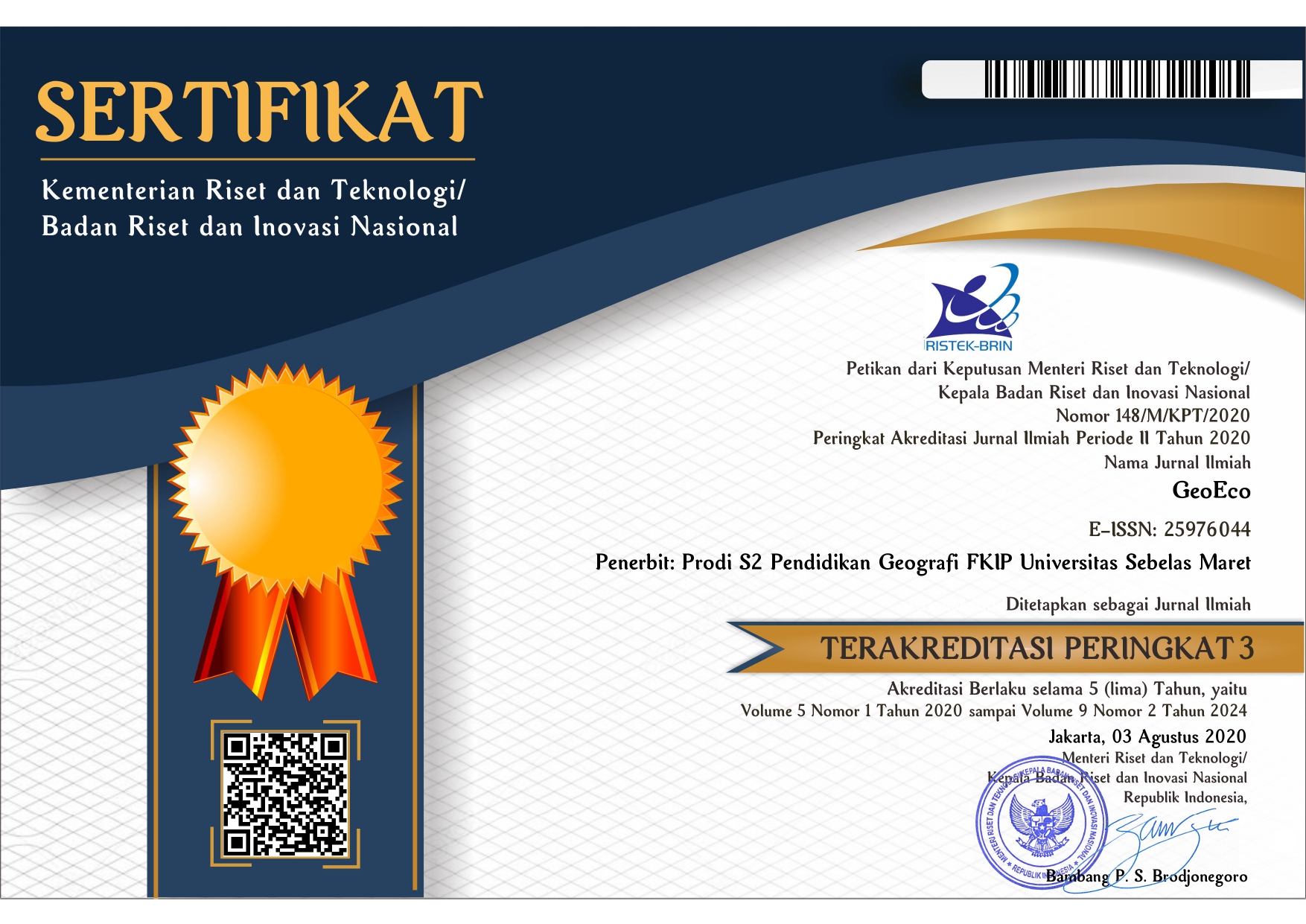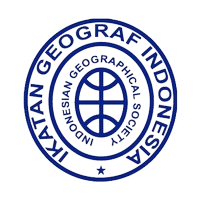COMMUNITY VULNERABILITY LEVELS IN THE COASTAL AREA OF PARIAMAN BEACH IN FACING EARTHQUAKE DISASTERS
Abstract
This study aims to obtain data, process, analyze and discuss the Community Vulnerability in the Coastal Areas of Pariaman City in Earthquake Disaster Mitigation. This type of research is descriptive qualitative. The population in this study are villages along the coast of Pariaman. Total population of 1117 households (KK). Sampling of respondents based on Proposional Random Sampling, namely 10% of the total population, so that the respondents totaled 117 people. Data collection techniques using questionnaires and interviews. Descriptive qualitative data analysis used frequency and percentage tables. The results of this study indicate the level of community vulnerability in the coastal area of Pariaman in earthquake mitigation shows a high vulnerability category. The general public must always be given outreach on a regular basis to be able to understand about knowledge before a disaster, during a disaster and after a disaster.
Keywords
Full Text:
PDFReferences
Alfi, M., Darsiharjo, & Maryani, E. (2019). Development of Natural Disaster Mitigation Teaching Materials to Improve Understanding of Disasters. Journal of Physics: Conference Series, 1387(1). https://doi.org/10.1088/1742-6596/1387/1/012079 Amri, A., Bird, D. K., Ronan, K., Haynes, K., & Towers, B. (2017). Disaster risk reduction education in Indonesia: Challenges and recommendations for scaling up. Natural Hazards and Earth System Sciences, 17(4), 595–612. https://doi.org/10.5194/nhess-17-595-2017 Aydan, O. (2008). Aydan2008.Pdf. Baru, A. (2007). Masri Singarimbun dan Sofyan Effendi , Metode Penelitian Survey , LP3ES , Manajemen , 2001–2002. BNPB. (2015). Definisi dan Jenis Bencana. Badan Nasional Penanggulangan Bencana, 2–5. https://doi.org/10.1016/j.cell.2007.05.058 BNPB. (2017). Latihan Kesiapsiagaan Bencana, 145. Bullock, J. A., Haddow, G. D., & Coppola, D. P. (2013). Mitigation, Prevention, and Preparedness. Homeland Security, 237–268. https://doi.org/10.1016/B978-0-12-415803-0.00010-6 Cardona, O. D. (2005). A system of indicators for disaster risk management in the Americas. Measuring Vulnerability to Natural Hazards: Towards Disaster Resilient Societies, 189–209. Carley, K. M., Malik, M., Landwehr, P. M., Pfeffer, J., & Kowalchuck, M. (2016). Crowd sourcing disaster management: The complex nature of Twitter usage in Padang Indonesia. Safety Science, 90, 48–61.https://doi.org/10.1016/j.ssci.2016.04.002 Chikoto, G. L., Sadiq, A. A., & Fordyce, E. (2013). Disaster Mitigation and Preparedness: Comparison of Nonprofit, Public, and Private Organizations. Nonprofit and Voluntary Sector Quarterly, 42(2), 391–410. https://doi.org/10.1177/0899764012452042 Cutter, S. L., Boruff, B. J., & Shirley, W. L. (2003). Social vulnerability to environmental hazards. Social Science Quarterly, 84(2), 242–261. https://doi.org/10.1111/1540-6237.8402002 Danny Hilman Natawidjaja. (2007). Gempabumi dan Tsunami di Sumatra dan Upaya Untuk Mengembangkan Lingkungan Hidup. Gempa Bumi, 1–3(December), 66. Kankam, P. K. (2020). Approaches in Information Research. New Review of Academic Librarianship, 26(1), 165–183. https://doi.org/10.1080/13614533.2019.1632216 LIPI-UNESCO/ISDR. (2006). Kajian Kesiapsiagaan Masyarakat dalam Mengantisipasi Bencana Gempabumi dan Tsunami, 579. Retrieved from http://www.bukue.lipi.go.id/utama.cgi?lihatarsip&jans001&1273262299&51 Maryani, E., & Yani, A. (2001). Kearifan Lokal Masyarakat Sunda Dalam Memitigasi Bencana Dan Aplikasinya Sebagai Sumber Pembelajaran Ips Berbasis Nilai. In Jurnal Penelitian Pendidikan (Vol. 14). Retrieved from http://ejournal.upi.edu/index.php/JER/article/view/3111/2132 McCloskey, J., Antonioli, A., Piatanesi, A., Sieh, K., Steacy, S., Nalbant, S., … Dunlop, P. (2008). Tsunami threat in the Indian Ocean from a future megathrust earthquake west of Sumatra. Earth and Planetary Science Letters, 265(1–2), 61–81.https://doi.org/10.1016/j.epsl.2007.09.034 Mileti, D. (1999). Disasters by Design. Disasters by Design. https://doi.org/10.17226/5782 MUHARI, A., DIPOSAPTONO, S., & IMAMURA, F. (2007). Toward an Integrated Tsunami Disaster Mitigation: Lessons Learned from Previous Tsunami Events in Indonesia. Journal of Natural Disaster Science, 29(1), 13–19. https://doi.org/10.2328/jnds.29.13 Rahmi, Y., & Satria, A. (2013). Correlation Analysis beetwen the Level of Vulnerability of Coastal Communities with Efforts of Disaster Risk Reduction. Penyuluhan, 9(2), 185–199. Röbke, B. R., & Vött, A. (2017). The tsunami phenomenon. Progress in Oceanography, 159(September), 296–322. https://doi.org/10.1016/j.pocean.2017.09.003 Spittal, M. J., McClure, J., Siegert, R. J., & Walkey, F. H. (2008). Predictors of two types of earthquake preparation: Survival activities and mitigation activities. Environment and Behavior, 40(6), 798–817. https://doi.org/10.1177/0013916507309864 Twigg, J., Greig, B., & Lanka, S. (2001). Sustainable Livelihoods and Vulnerability. Management, (March), 10–11. https://doi.org/10.13140/RG.2.2.20436.42889 Wisner, B., Blaikie, P., Cannon, T., & Davis, I. (2003). At Risk : natural hazards , people ’ s vulnerability and disasters Second edition The attached three chapters constitute Part I of the book , and have been made available in the public domain by the authors and Routledge as part of the UNDP follow up to t. Framework, 134.
Refbacks
- There are currently no refbacks.












.png)

